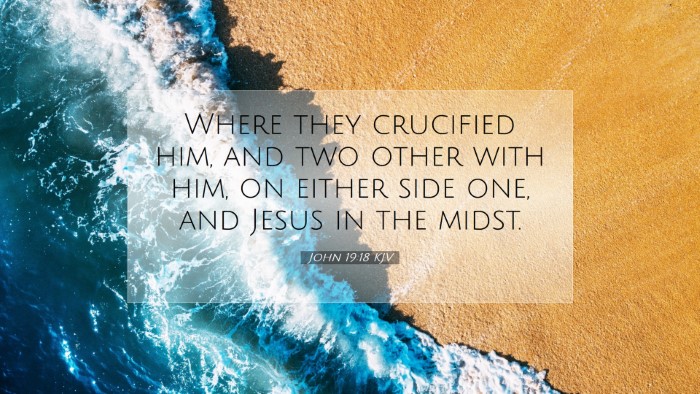Commentary on John 19:18
"Where they crucified him, and two others with him, on either side one, and Jesus in the midst."
Introduction
The narrative of the crucifixion of Christ is a profound element in the New Testament, particularly in the Gospel of John. This passage, John 19:18, succinctly describes a pivotal moment in the history of salvation—the execution of Jesus. This event, though a historical reality, also holds deep theological significance and raises various themes worthy of exploration.
The Historical Context
In this verse, the scene unfolds at Golgotha, also known as Calvary, where Jesus is executed among two criminals. This method of execution was a Roman practice reserved for the gravest offenders. It serves to emphasize the extreme humiliation and suffering inflicted upon Jesus, the innocent Lamb of God, who willingly submits to such treatment for the salvation of humanity.
Commentary Insights
-
Matthew Henry's Perspective:
Henry points out the fulfillment of prophecy in this verse, noting the significance of Jesus being crucified with thieves. It underscores the depth of His humility and the extent of His identification with sinners. He highlights that this moment reflects not merely Jesus' suffering but the reality of His mission as the Savior who bears the sins of the world.
-
Albert Barnes' Observations:
Barnes elaborates on the location of the crucifixion. He notes that the presence of two other criminals – one on either side of Jesus – illustrates the theme of separation and isolation that often accompanies disobedience and rebellion against God. Yet, in this great act of injustice, Jesus occupies the central position, symbolizing His role as the chief among sinners bearing their sin.
-
Adam Clarke's Commentary:
Clarke examines the 'midst' of the two thieves, asserting that it conveys a theological commentary on Jesus’ nature as both central to mankind's redemption and equally affected by the world's sin. He emphasizes that Jesus, though placed amidst transgressors, is the preeminent mediator interceding on behalf of humanity. Clarke also notes the cultural implications of crucifixion and how it was designed to invoke fear, further highlighting the extremity of Christ's sacrifice.
Theological Reflections
This verse not only recounts historical facts but invites deep theological pondering. The image of Jesus crucified between two criminals can be seen as a poignant articulation of the Gospel's inclusivity. Just as He was placed between two thieves, so too is He willing to embrace all who are condemned. His sacrificial act becomes a divine embrace for the lost and hopeless.
Moreover, the placement of Jesus highlights a significant theological truth—that in our moments of greatest depravity, Christ is present. He does not stray from us in our sin; rather, He draws nearer, bestowing His grace in the midst of our failures.
Application for Today
For pastors, students, and theologians, this verse serves as a reminder of Christ's unyielding compassion and willingness to be identified with the worst of society. In contemporary ministry, this calls us to engage with marginalized individuals, recognizing that within our world of sin and suffering, Christ is already present.
This passage also reminds believers of the costly nature of discipleship. Just as Jesus faced humiliation and suffering, followers of Christ are called to take up their crosses. The crucifixion is not only the means of salvation but also a model for sacrificial living in service to others.
Furthermore, reflecting on the crucifixion's inherent injustice encourages believers to confront and respond to social injustices today, standing in solidarity with the oppressed and disenfranchised as Christ did.
Conclusion
In summary, John 19:18 captures a moment that is rich in historical, prophetic, and theological significance. Through the insights of respected commentators such as Matthew Henry, Albert Barnes, and Adam Clarke, we grasp not only the narrative itself but the layers of meaning embedded within it. As we meditate on this verse, let us be inspired to walk in the footsteps of Christ, bearing witness to His redemptive love in a world still in need of hope and healing.


